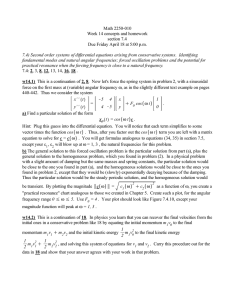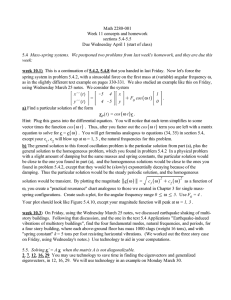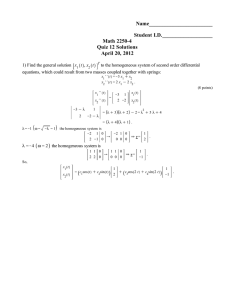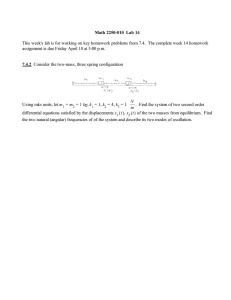Math 2280-001 Week 10 concepts and homework sections 5.3-5.4 Due Friday March 27
advertisement
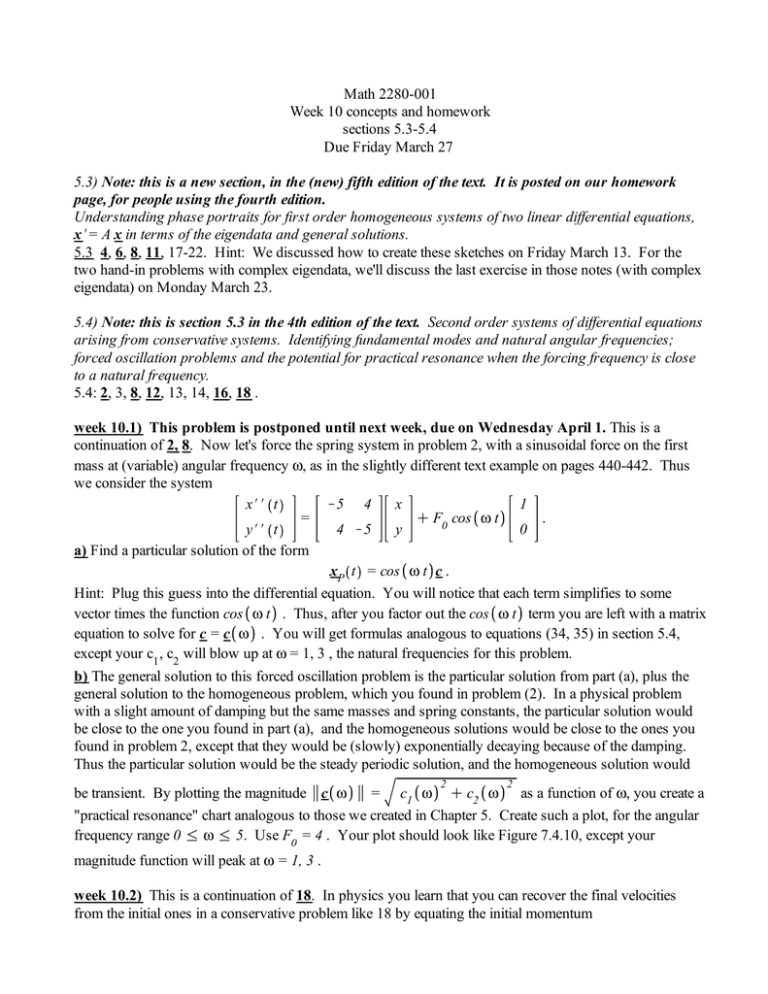
Math 2280-001 Week 10 concepts and homework sections 5.3-5.4 Due Friday March 27 5.3) Note: this is a new section, in the (new) fifth edition of the text. It is posted on our homework page, for people using the fourth edition. Understanding phase portraits for first order homogeneous systems of two linear differential equations, x#= A x in terms of the eigendata and general solutions. 5.3 4, 6, 8, 11, 17-22. Hint: We discussed how to create these sketches on Friday March 13. For the two hand-in problems with complex eigendata, we'll discuss the last exercise in those notes (with complex eigendata) on Monday March 23. 5.4) Note: this is section 5.3 in the 4th edition of the text. Second order systems of differential equations arising from conservative systems. Identifying fundamental modes and natural angular frequencies; forced oscillation problems and the potential for practical resonance when the forcing frequency is close to a natural frequency. 5.4: 2, 3, 8, 12, 13, 14, 16, 18 . week 10.1) This problem is postponed until next week, due on Wednesday April 1. This is a continuation of 2, 8. Now let's force the spring system in problem 2, with a sinusoidal force on the first mass at (variable) angular frequency w, as in the slightly different text example on pages 440-442. Thus we consider the system x## t K5 4 x 1 = C F0 cos w t . y## t 4 K5 y 0 a) Find a particular solution of the form xP t = cos w t c . Hint: Plug this guess into the differential equation. You will notice that each term simplifies to some vector times the function cos w t . Thus, after you factor out the cos w t term you are left with a matrix equation to solve for c = c w . You will get formulas analogous to equations (34, 35) in section 5.4, except your c1 , c2 will blow up at w = 1, 3 , the natural frequencies for this problem. b) The general solution to this forced oscillation problem is the particular solution from part (a), plus the general solution to the homogeneous problem, which you found in problem (2). In a physical problem with a slight amount of damping but the same masses and spring constants, the particular solution would be close to the one you found in part (a), and the homogeneous solutions would be close to the ones you found in problem 2, except that they would be (slowly) exponentially decaying because of the damping. Thus the particular solution would be the steady periodic solution, and the homogeneous solution would 2 2 be transient. By plotting the magnitude c w = c1 w C c2 w as a function of w, you create a "practical resonance" chart analogous to those we created in Chapter 5. Create such a plot, for the angular frequency range 0 % w % 5. Use F0 = 4 . Your plot should look like Figure 7.4.10, except your magnitude function will peak at w = 1, 3 . week 10.2) This is a continuation of 18. In physics you learn that you can recover the final velocities from the initial ones in a conservative problem like 18 by equating the initial momentum m1 v0 to the final momentum m1 v1 C m2 v2 and the initial kinetic energy 1 m v2 to the final kinetic energy 2 1 0 1 1 m1 v21 C m2 v22 , and solving this system of equations for v1 and v2 . Carry this procedure out for the 2 2 data in 18 and show that your answer agrees with your work in that problem. week 10.3) This problem is postponed until next week, due on Wednesday April 1. On Wednesday March 25 we will discuss earthquake shaking of multi-story buildings. Following that discussion, and the one in the text 5.4 Applications "Earthquake-induced vibrations of multistory buildings", find the four fundamental modes, natural frequencies, and periods, for a four story building, where each above-ground floor has mass 1000 slugs (weight 16 tons), and with "spring constant" k = 5 tons per foot resisting horizontal vibrations. (We will work out the three story case on Wednesday.)
